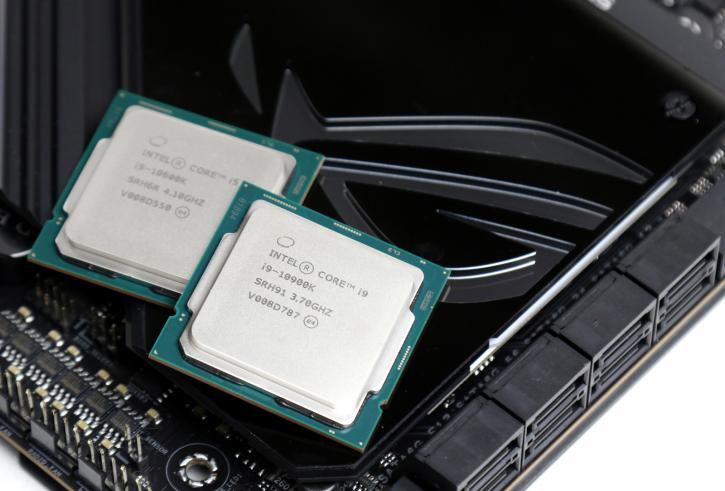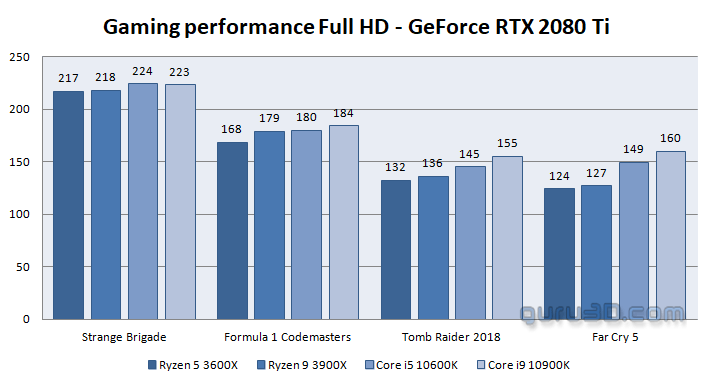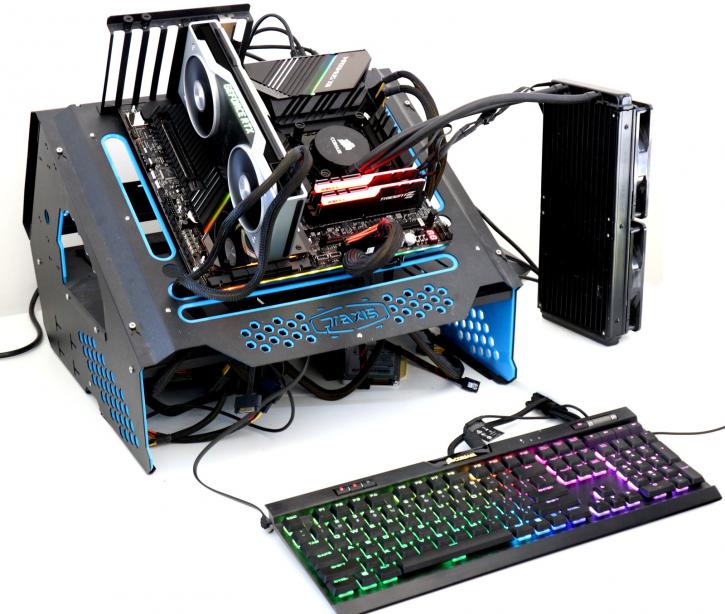Final Words & Conclusion
Final words & conclusion
It has been a long wait, but finally, you've been able to read up what Comet Lake-S is all about, as the 10th generation Core desktop processors are here. There's a lot to talk about though for this conclusion. The years 2019 and 2020 have been challenging for Intel on that desktop processor front, never has the competition been more present throughout the desktop and many-core processor market. Today's tested product is challenging the AMD Ryzen 3000 series alright, but each has that own advantages and disadvantages. For example, some level of PCIe Gen 4.0 support for Comet Lake-S would have been preferred, even if it was only x4 PCIe Gen4 to support at CPU level one M2 unit at PCIe Gen 4.0. It's a bit of a missed opportunity really. The relevancy of PCIe Gen 4.0 M2./ NVMe SSDs however still is debatable at best, but the coming year we'll see that host infrastructure advance with much faster NVMe based SSDs, and that's where its importance will grow. The processor series requires a new motherboard, a year from now Rocket Lake-S will be released, and yeah these will be the only two CPU series that will be supported on this infrastructure. I've stated this in a recent discussion here on the website and forums, but considering that you upgrade a motherboard+CPU likely once every four years, we do not see it as incredibly significant for your purchasing decisions.
From a processor architecture point of view, little is new in features really. We do like the snazzy sharp peak performance that the Core i9 10900K offers, but we can also tell that Intel had to open up a bag of tricks to be able to accomplish that. Of course, I am referring to the long turbo power states of a PL2 mode that last 57 seconds at high energy consumption. There's little wrong with that as it is not something new, however, what is new is the duration and power allowance, both doubled up so that means this 125 Watt processor is allowed to jump to 250 Watts for nearly a minute. That will have an effect on heat, so cool this puppy wisely. TDP as a discussion by itself, do people really care about it? Not so much really, but processors jumping towards 250 Watts is a lot, let's be honest there. And if you allow your processor to run to 250 Watts for a minute, should this not have been called a 250 Watt TDP processor?
Overall there's no denying it, this processor is fast and agile, at close to 500 USD the 10900K is fighting off that similar priced Ryzen 9 3900X, which offers two more cores at 12-cores for pretty much the same amount of money. Seen from that perspective, Intel will likely need to further lower its price for this proc to remain competitive. Purely speaking from a game performance point of view, Intel has the lead. And you will need to acknowledge that the gaming performance is a notch better compared to the competition when you fire an enthusiast-class GPU at the platform. That all comes back towards the high-frequency Turbos Intel can apply, running up to 5.3 GHz (depending on conditions). Processors like shown today are of course good stuff for the streamers, video editors, content creators, the developers and companies that need to run a fairly affordable multi-core server for a bit of virtualization and such. Here the Core i9-10900K performs well. But is it enough though?, well that is hard to answer question really, again the competition is very strong in threaded and single-threaded performance with applications, it's only gaming combined with 1000 USD graphics cards where they perform a notch-less. You do need to look at platform differences, AMD offers PCIe Gen4.0 throughout the eco-system, whereas with Comet-Lake-S sticks at Gen 3.0, albeit the Z490 motherboards are gen 4.0 ready, but that likely is introduced with Rocket Lake-S series desktop processors.
Performance & tweaking
We'd rate the new 10-core part as "very good" for the results as tested. Temps remain trivial to judge but certainly did not disappoint at processor defaults (depending on the choice of cooling), we obviously are going to recommend a proper LCS cooler. At the OC levels you are looking at 1.35V and higher needed on that CPU core for a decent tweak, however, and that is the same for AMD, tweaking many-core processors is complicated as you are bound to run into core limitations, heat and power consumption. With processor like these, you really need to wonder if you want to tweak, as really, the best configuration is already there at defaults. At fairly low voltages you'll reach an all-core 5000 MHz, LCS got us towards 5.2 GHz (all cores). At that stage, we are closing in at 360 Watts power consumption ergo my plea to leave the proc at its default configuration. Of course, we receive Intel supplied samples, so we cannot state anything conclusive on the final retail products in matters of tweaking (yours might run a notch better). The infrastructure that Z490 offers is sound as well as has proven to be reliable and easy to use. Tweaking wise you increase the CPU voltage and multiplier and you are good to go. Another plus for the Intel platform is that over the years they have been able to refine their memory controllers, pop in anything XMP 2.0 and you have a 98% chance it'll work straight out of the box with very fast memories. However, the effect of faster frequency memory is far less significant, so opt volume would be my advice. We'd always suggest going with a nice affordable 3200 or maybe a 3600 MHz kit.
Gaming performance
As far as gaming goes, the pure raw wins are mostly for Intel, but everything is relative when it comes to gaming as 98% of the time your actual limitation is the GPU, and not CPU. Ergo, for gaming GPUs matter more than CPUs. You can measure the effect of CPU performance with games, but only when you steer away from that GPU bottleneck, that's why we use a 1000+ USD graphics card, and only then in the lower resolutions you'll see substantial enough differences. But with a Radeon RX 5700 or GeForce RTX 2070, these differences would be much closer towards equal for one another. Hey, everything is relative. Let's have a peek here at the chart below. That's a 1920x1080 (Full HD) gaming chart based on the reference GeForce RTX 2080 Ti.
The vast majority of you guys have a far more GPU limited graphics card. So while I am absolutely not evangelizing or recommending 10 cores for gaming these days, the reality absolutely and unequivocally is that you can game pretty darn well with a lower-cost processor as well. However, if you need 144 FPS at Full HD, the symbiosis of a faster processor and GPU can make a difference (at great cost). Currently, I find 8-core processors a sweet spot in relation to gaming, 6-cores for value.
Power consumption
With ten cores you get a 125 Watt TDP processor. But as explained, it all is a little more complicated these days. Intel applies a secondary power stage where the processor is allowed to run twice the TDP value for a pretty long time. That's a holy grail for added threading performance, it does, however, make energy consumption peak with higher values during that long boost. With the system at idle with a GeForce RTX 2080 Ti installed / 16 GB memory / SSD and the Z490 motherboard hovers at roughly 70 Watts. That's just fine really, but the load values are significant. When we stressed the processor 100% run we reach roughly 295 Watts with this 10-core processor (for the entire PC).
Life span
One thing I do like to address is the life-span of this platform. Comet Lake-S and Rocket-Lake-S will be the only two generations processors that will work on the LGA1200 series motherboards. That means you will not be able to upgrade fast based on your motherboard. Next year in 2021 architectures like Alder Lake-S already have been scheduled, it's mentioned that the pin count once again will change to 1700, a socket LGA1700. So while LGA1200 has just been introduced it will last roughly one year before becoming obsolete as an upgrade path.
Conclusion
Processor conclusions are never easy to write up as there are many factors involved as well as multiple pros and cons for each side and brand. Intel certainly gains the most out of the 14nm fabrication node compared to AMD. At 14nm they are able to reach 5.3 GHz (under strict conditions like PL2 and thermals). This brings Intel good peak performance which shows in gaming performance as well as boosting multi-threaded performance. The flip-side of that coin is that once the processor returns to its original PL1 state, that threading performance becomes less strong. It is one of the reasons that we recently moved towards test suite software that sometimes runs 10 to 15 minutes or even an hour to test, which, in our belief, paints a more accurate picture. Tagged in there is IPC, the main factor to consider as IPC x your clock frequency really is the holy grail of it all. So clock for clock AMD with ZEN2 has better IPC, and Intel better (and longer) high clock frequencies, and that's the tradeoff between the two brands.
Each of the architectures will show advantages and disadvantages. Both processor series, however, are really good. Platform wise Z490 in combination with Comet lake-S really isn't that different from last-gen and makes this a harder sell to spend money on an upgrade. Imho, Intel really needed PCIe Gen 4.0 here today, on this platform to make a substantial difference. The majority of platform vulnerabilities will have been patched at the hardware level where possible, and soft and firmware otherwise. The performance certainly is there. Another trump card for Intel is that they came down on prices. At close to 500 USD the 3900X from AMD is now the competing processor. Gaming wise with only the most expensive GPUs Intel wins, threading, and overall performance-wise, for that money AMD has a more mature platform with the performance that comes along with that in all other segments. But as so often, platform and brand preference will be important for any potential consumer, there's a camp intel and a camp AMD. Tweaking wise there is a lot to say for the Core i9 10900K, as explained 5000~5100 MHz all cores is quite easy and I do foresee some lucky folks reaching a stable 5.3 GHz on all 10 cores. We halted at 5200 MHz for reasons of heat. You also really need to wonder if it is worth it (tweaking and overclocking), you are dealing with extensive power consumption and heat levels. But for kicks and giggles, sure why not.
No matter what you choose, if it's time for a long-awaited upgrade you will enjoy the platform and performance. Yesterday's HEDT is has become today's mainstream. Seen and upgrading from the Core i9 9900K(S) things are more difficult to advise though. But yes, we can certainly recommend Comet Lake-S if you take all the variables we mentioned in mind, as the 10900K is a bit of a beast alright, you'll have a platform game performance advantage over the competition, however only with the most expensive GPUs, albeit that difference is getting more and more marginal as well. We do have one worry, and it's not the processor. The Z490 motherboard all seems steeply-priced starting at 175 USD running to even 1000 USD. For the mainstream desktop segment, that's a lot. Regardless, we'll happily hand out a recommended award for the Core i9 10900K.
Handy related downloads:
- Sign up to receive a notification when we publish a new article
- Or go back to Guru3D's front page





